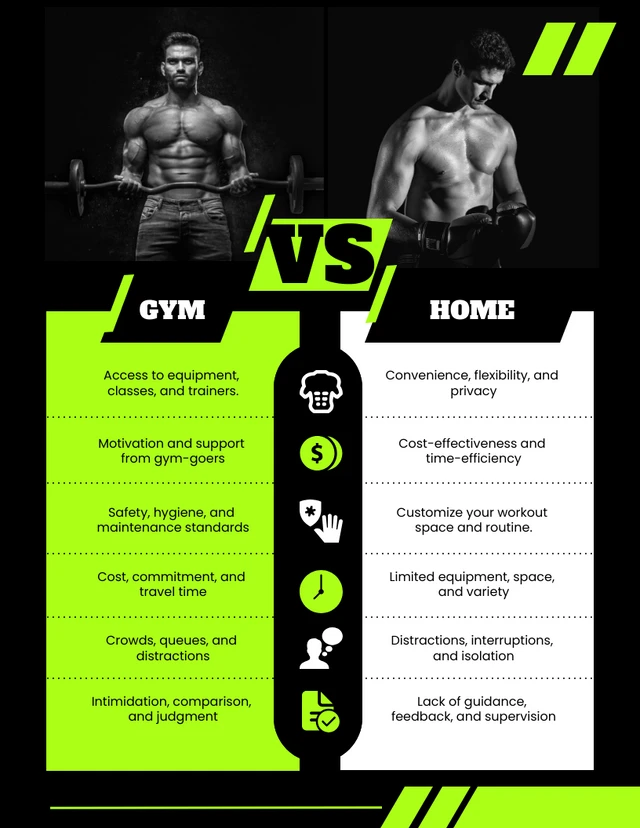Are you trying to decide between hitting the gym or working out at home? This choice can feel overwhelming because both options promise great results.
But which one truly fits your lifestyle, goals, and motivation? Understanding the key differences will help you make a smart decision that keeps you consistent and excited. Keep reading, and you’ll discover which workout setting can give you the best boost—so you can reach your fitness goals faster and enjoy every step of the way.

Credit: venngage.com
Benefits Of Gym Workouts
Gym workouts offer many benefits that help people stay fit and healthy. Gyms provide a strong environment for exercise. They support different fitness goals for all levels. Many prefer gyms because they offer variety and structure.
Working out at a gym can improve strength, endurance, and overall health. It also helps keep motivation high. The gym setting encourages regular exercise habits.
Access To Equipment
Gyms have many machines and free weights. This equipment targets different body parts. People can choose what fits their workout plan. Using machines can reduce injury risk. Equipment variety helps avoid workout boredom. Many exercises are only possible at a gym.
Professional Guidance
Gyms offer trainers who guide workouts safely. Trainers create plans based on goals and fitness levels. They teach correct form to prevent injuries. Getting advice speeds up progress. Trainers also help with motivation and consistency. Support from experts makes workouts more effective.
Social Motivation
Gyms bring people together with similar goals. Seeing others exercise can inspire effort. Group classes create a sense of community. Meeting workout partners helps stay accountable. Social interaction turns exercise into a fun activity. Motivation grows from shared experiences and support.
Advantages Of Home Workouts
Home workouts offer many benefits that fit everyday life. They allow people to exercise without leaving their house. This makes staying active easier for many. The advantages of home workouts go beyond just saving time. They can save money and create a comfortable space for exercise.
Convenience And Flexibility
Working out at home means no travel time. You can exercise anytime you want. No need to follow gym hours or wait for machines. This fits well with busy schedules. You can do short workouts or long sessions. Change exercises based on your mood or energy. This freedom helps keep exercise a habit.
Cost-effectiveness
Home workouts cut down on gym fees. No monthly membership or extra costs. Use bodyweight exercises or simple equipment. Items like dumbbells or resistance bands cost less. Many free workout videos exist online. Save money while still getting a good workout. This makes fitness affordable for more people.
Privacy And Comfort
Exercising at home gives privacy. No watching eyes or crowded spaces. You can wear what you want and move freely. This helps reduce stress and anxiety. Home is a safe and familiar place. It encourages more focus and effort. Comfort boosts motivation to keep going.
Comparing Effectiveness
Choosing between gym workouts and home workouts depends on how effective each is for your fitness goals. Effectiveness means how well the workout helps you improve strength, stamina, and health. Both places offer benefits and challenges for your progress.
Workout Intensity
Gyms have more equipment that lets you work out harder. You can use weights, machines, and cardio tools to boost intensity. At home, intensity depends on your gear and space. Bodyweight exercises can be strong but may limit growth over time.
Consistency And Discipline
Home workouts need strong self-control. No one is watching, so skipping is easy. Gyms create a focused environment that helps many people stay consistent. The routine of going out can build good habits and reduce distractions.
Goal Achievement
Gyms suit goals like muscle building and weight loss better. They offer variety and support that speed progress. Home workouts work well for general fitness and flexibility. Clear goals and a plan matter more than location for success.
Common Challenges
Choosing between gym workouts and home exercises comes with its own set of challenges. Both options demand focus and motivation. Understanding common hurdles helps you stay on track. Challenges can affect your workout quality and consistency. Addressing these issues makes fitness routines easier and more effective.
Overcoming Gym Intimidation
Many people feel nervous at the gym. New machines and fit people can seem scary. This fear stops some from going regularly. Start by visiting the gym during quiet hours. Watch others to learn how equipment works. Ask staff for help with exercises or machines. Remember, everyone was a beginner once. Focus on your own progress. Small steps build confidence over time.
Avoiding Home Workout Distractions
Home workouts have many distractions nearby. Phones, TV, and family can break focus. Create a specific workout space to stay focused. Turn off notifications during exercise time. Set a clear schedule for workouts. Let others know your workout time is important. Keep workout gear ready to avoid excuses. Staying disciplined helps maintain a steady routine.
Equipment Essentials For Home
Setting up a workout space at home starts with the right equipment. It helps you stay consistent and improve your fitness. You do not need a lot of tools to begin. Just a few items can support many exercises.
Choosing the right gear depends on your fitness level and goals. Basic equipment suits beginners. Advanced tools help increase challenge and variety. Both types of gear can fit in small spaces. Let’s explore what you need to start and how to upgrade later.
Basic Gear For Beginners
A yoga mat is essential for comfort and safety. It provides cushioning for floor exercises and stretching. Resistance bands are cheap and versatile. They add resistance without heavy weights. A pair of dumbbells, 3 to 5 pounds, helps build strength gradually. A jump rope boosts cardio and coordination. These items cover most beginner workouts easily.
Upgrading For Advanced Training
Adding adjustable dumbbells saves space and adds weight options. A kettlebell offers dynamic moves for strength and balance. A pull-up bar helps develop upper body muscles. Medicine balls increase core strength and power. A stability ball improves balance and flexibility. These tools support more intense and varied workouts at home.
Time Management Tips
Managing time well makes workouts easier and more consistent. Choosing between gym or home workouts depends on your daily schedule. Good time management helps you stay active without stress.
Scheduling Gym Sessions
Pick specific days and times for gym visits. Mark them on your calendar or phone. Treat these sessions like important appointments. Avoid skipping to keep your routine steady. Plan for travel and changing clothes. This keeps your workout time focused and efficient.
Fitting Workouts Into Home Routine
Use small pockets of free time for exercise at home. Try short workouts during breaks or before meals. Keep workout gear visible as a reminder. Combine exercises with daily tasks, like stretching while watching TV. This helps keep exercise regular without extra time needed.
Budget Considerations
Budget plays a big role in choosing between gym workouts and home workouts. Your money decides what type of exercise you can do regularly. Both options have costs that add up over time. Knowing these costs helps you pick the best choice for your wallet and goals.
Gym Membership Costs
Gym memberships often charge monthly or yearly fees. These fees can vary a lot based on location and gym quality. Some gyms offer discounts for long-term contracts. Others charge extra for special classes or personal training. You also spend on travel and parking to reach the gym. These costs can add up quickly over months or years.
Investing In Home Equipment
Home workouts need some initial equipment investment. You might buy weights, mats, or machines like treadmills. The prices range from cheap to very expensive. You pay once, but good equipment lasts many years. You save money on travel and gym fees. Still, space and maintenance of equipment are important to consider.

Credit: toneopfit.com
Personal Preferences And Lifestyle
Choosing between gym workouts and home exercises depends a lot on personal preferences and lifestyle. What fits one person may not suit another. Your daily routine, goals, and habits shape this choice.
Think about how you stay motivated and what kind of environment helps you exercise regularly. Also, consider if you enjoy social interaction during workouts or prefer solitude. These factors affect your workout success.
Assessing Your Motivation Style
Some people find it easy to push themselves at home. They like quiet and focus. Others need the energy of a gym to stay motivated. The sounds, machines, and other people can inspire effort. Knowing what drives you helps pick the right place to exercise.
Motivation can come from routine too. Some need a set schedule, like gym classes or appointments. Others prefer flexible times and work out whenever they want. Your style of motivation guides your workout choice.
Adapting To Social Needs
Exercise can be social or solitary. Some enjoy meeting friends or trainers at the gym. This social support boosts mood and commitment. Others feel shy or distracted around people. They prefer home workouts to avoid pressure.
Social needs also depend on how busy your life is. If you have little free time, home workouts save travel and waiting. If you want to meet new people or join group classes, gyms offer more options. Match your social style to your workout place.
Making The Final Choice
Choosing between gym workouts and home workouts can feel tough. Each option has clear benefits and some drawbacks. The right choice depends on what fits your life and goals best. This section helps you make that final decision with simple steps.
Evaluating Priorities
Think about what matters most to you. Is it saving money or having many machines? Do you prefer social settings or quiet spaces? Consider your daily schedule and how much time you can spend on workouts. Your fitness goals also play a big role. Strength building might need gym tools. Weight loss can happen anywhere. Write down your top three priorities. Use them as a guide for your choice.
Trial Periods And Adjustments
Try both options for a short time. Visit a gym for a week or two. Do home workouts for the same time. Notice how each feels. Is one easier to stick with? Do you enjoy the environment? Adjust your routine based on what works. It is okay to mix both. Maybe gym workouts a few days and home sessions on others. Small changes help find a balance you like.

Credit: venngage.com
Frequently Asked Questions
Is Gym Workout More Effective Than Home Workout?
Gym workouts offer diverse equipment and professional guidance. This variety helps target muscles better. Home workouts are flexible but may lack equipment. Effectiveness depends on your goals, consistency, and workout quality.
What Are The Cost Differences Between Gym And Home Workouts?
Gym memberships have monthly fees, sometimes additional charges for classes. Home workouts require initial equipment investment but no monthly fees. Over time, home workouts can be more economical if you invest wisely in equipment.
Can Home Workouts Build Muscle As Well As Gym Workouts?
Yes, home workouts can build muscle with proper resistance training. Using weights, resistance bands, or bodyweight exercises can be effective. Consistency and progressive overload are key for muscle growth at home or gym.
Which Is Safer: Gym Or Home Workout?
Both can be safe if done correctly. Gyms offer supervision and spotters for heavy lifts. Home workouts reduce exposure to germs but require self-discipline to maintain good form and avoid injury.
Conclusion
Choosing between gym and home workouts depends on your needs and lifestyle. Gyms offer equipment and social interaction. Home workouts save time and money. Both can help you stay fit and healthy. The key is staying consistent and motivated. Find what fits your schedule and comfort.
Enjoy exercising, no matter where you do it. Your fitness journey is personal and flexible. Keep moving forward, step by step.
